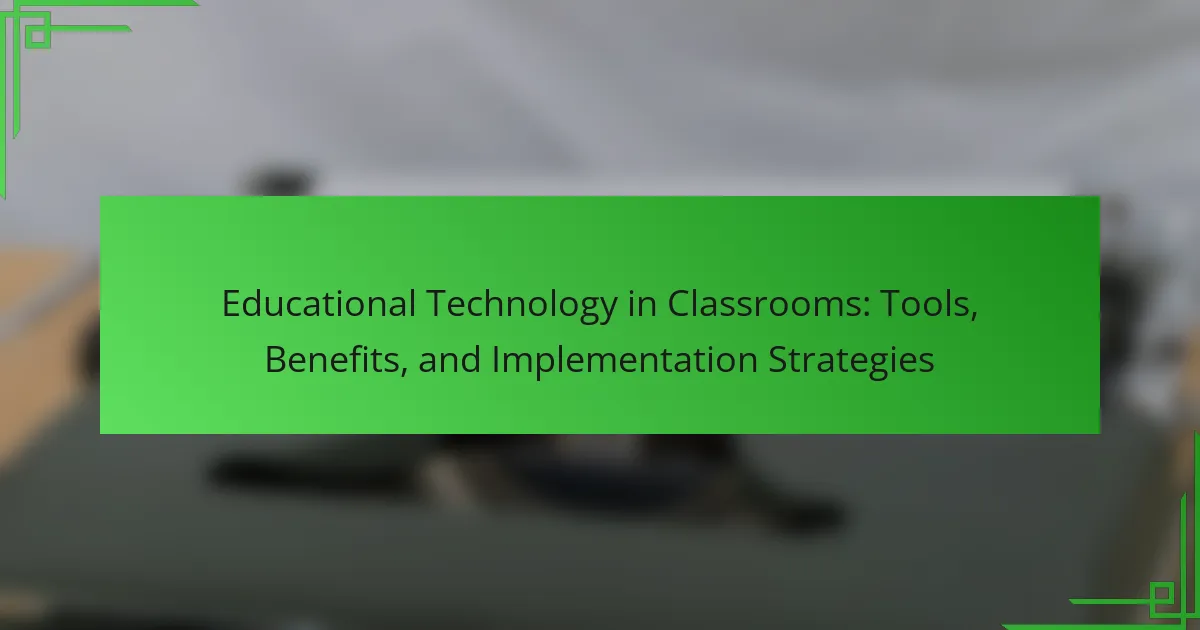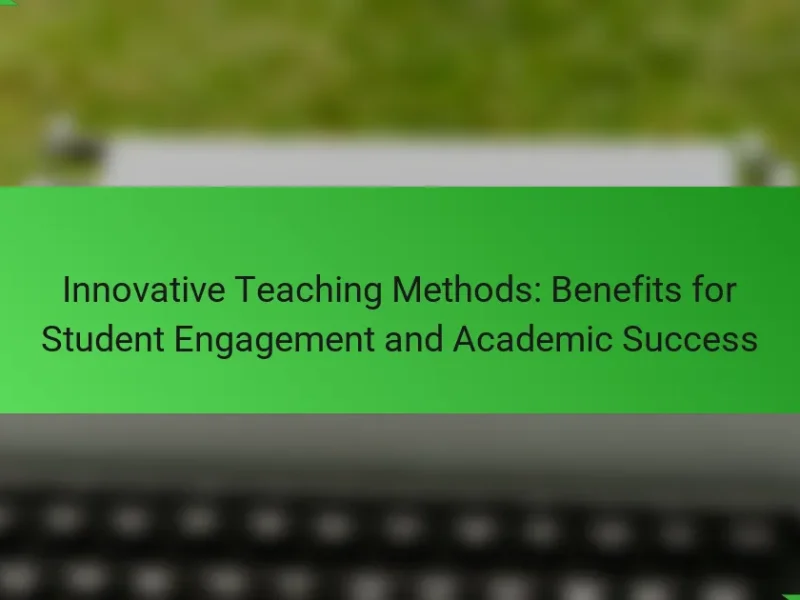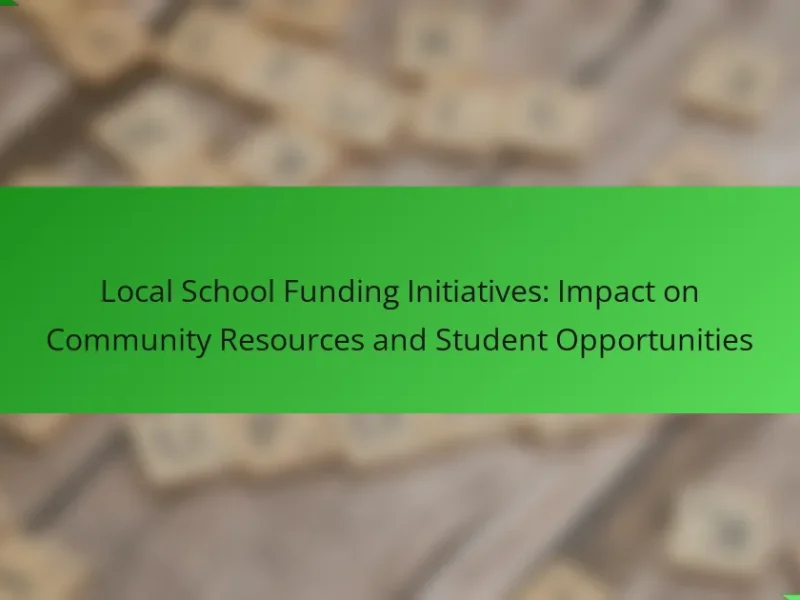Educational technology in classrooms encompasses the use of digital tools and resources, including software, hardware, and teaching methodologies, to enhance the learning experience. This technology supports diverse learning styles, promotes student engagement, and has been shown to improve academic performance, with studies indicating that students using educational technology achieve higher assessment scores. Key tools such as interactive whiteboards and learning management systems facilitate personalized learning and foster collaboration among students. Effective implementation strategies involve comprehensive training for educators, ongoing support, and stakeholder involvement, which collectively enhance the integration of technology in educational settings. Regular assessment of technology’s impact ensures alignment with educational goals and maximizes student outcomes.
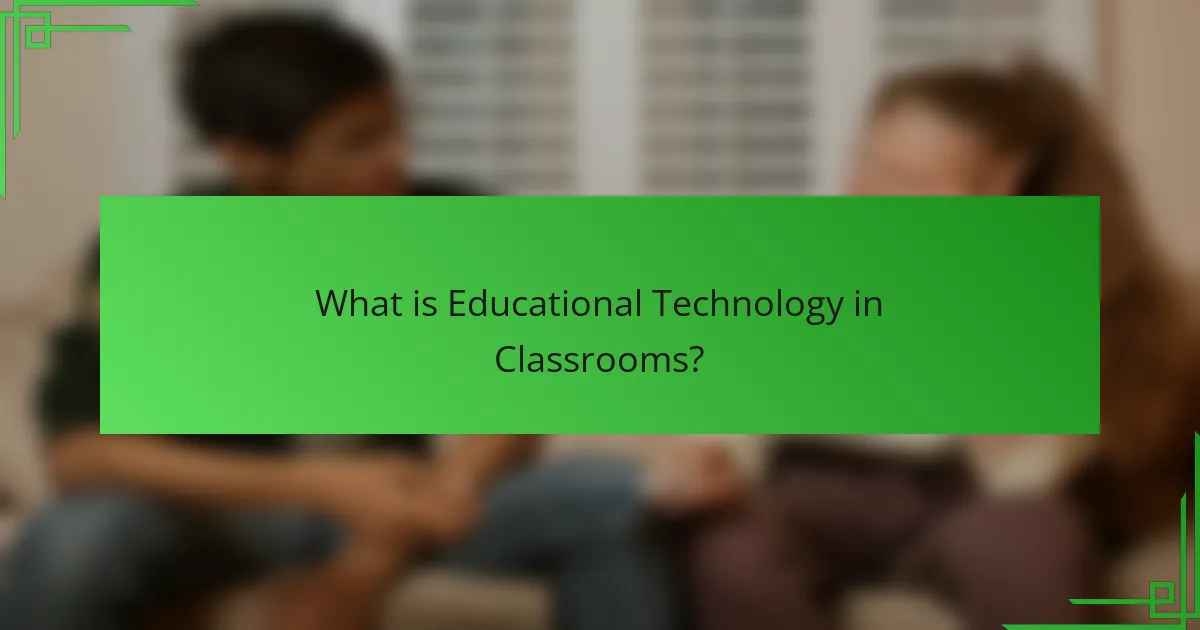
What is Educational Technology in Classrooms?
Educational technology in classrooms refers to the integration of digital tools and resources to enhance learning. It includes software, hardware, and teaching methodologies that facilitate educational processes. This technology supports various learning styles and improves student engagement. For instance, interactive whiteboards and learning management systems are commonly used. Research shows that educational technology can improve student outcomes by providing personalized learning experiences. According to a study published in the Journal of Educational Psychology, students using educational technology scored 10% higher on assessments than those who did not.
How has Educational Technology evolved over the years?
Educational technology has evolved significantly over the years. Initially, it focused on basic tools like chalkboards and overhead projectors. In the 1980s, personal computers began to enter classrooms, enhancing learning opportunities. The internet revolutionized educational technology in the 1990s, providing access to vast resources. By the 2000s, interactive whiteboards and learning management systems became common. Mobile devices emerged in the 2010s, allowing for personalized learning experiences. Today, artificial intelligence and virtual reality are shaping the future of educational technology. These advancements have transformed teaching methods and improved student engagement.
What are the key milestones in the development of Educational Technology?
The key milestones in the development of Educational Technology include the introduction of audiovisual aids in the 1920s. This marked the beginning of using media for educational purposes. The 1960s saw the emergence of computer-assisted instruction. This innovation allowed personalized learning experiences for students. In the 1980s, the advent of the personal computer revolutionized classroom learning. It made technology more accessible to educators and students alike. The internet’s rise in the 1990s transformed educational resources and communication. Online learning platforms began to gain popularity in the early 2000s. This shift enabled remote education and expanded access to learning materials. The integration of mobile devices in the 2010s further enhanced learning opportunities. Today, artificial intelligence is shaping the future of Educational Technology. These milestones reflect significant advancements in how technology is utilized in education.
How do advancements in technology influence classroom practices?
Advancements in technology significantly influence classroom practices by enhancing teaching methods and learning experiences. Digital tools such as interactive whiteboards and tablets promote engagement among students. These tools facilitate collaboration through shared documents and online platforms. Technology also enables personalized learning, allowing students to progress at their own pace. According to a study by the U.S. Department of Education, technology integration has been linked to improved student outcomes. Furthermore, virtual reality and simulations provide immersive learning experiences that traditional methods cannot offer. Overall, technology transforms the educational landscape, making learning more accessible and dynamic.
What are the main types of Educational Technology tools used in classrooms?
The main types of Educational Technology tools used in classrooms include Learning Management Systems (LMS), interactive whiteboards, and educational software. Learning Management Systems, like Moodle and Canvas, facilitate course management and student engagement. Interactive whiteboards enhance collaboration and interactivity during lessons. Educational software encompasses a wide range of applications, from subject-specific tools to general learning aids. These tools support diverse learning styles and improve educational outcomes. Research indicates that technology integration can lead to increased student motivation and achievement.
What are the differences between hardware and software tools?
Hardware tools are physical devices used in educational technology. Examples include computers, projectors, and tablets. Software tools are programs or applications that run on hardware. Examples include learning management systems, educational apps, and simulation software.
The primary difference lies in their nature. Hardware is tangible and can be touched. Software is intangible and consists of code and data. Hardware requires installation and maintenance of physical components. Software requires updates and may need troubleshooting for bugs.
In classrooms, hardware tools facilitate interaction and engagement. Software tools support learning processes and content delivery. Both are essential for effective educational technology integration.
How do interactive whiteboards enhance learning experiences?
Interactive whiteboards enhance learning experiences by promoting active engagement among students. They allow for dynamic presentations of information, making lessons more interactive. Students can participate directly by touching the screen, which fosters collaboration. This technology supports various learning styles, catering to visual, auditory, and kinesthetic learners. Research indicates that classrooms with interactive whiteboards see improved student retention rates. A study by Hattie (2009) shows that interactive technologies can increase student achievement. Additionally, teachers can easily integrate multimedia resources, enriching the learning environment. Overall, interactive whiteboards transform traditional teaching methods into more effective and engaging experiences.
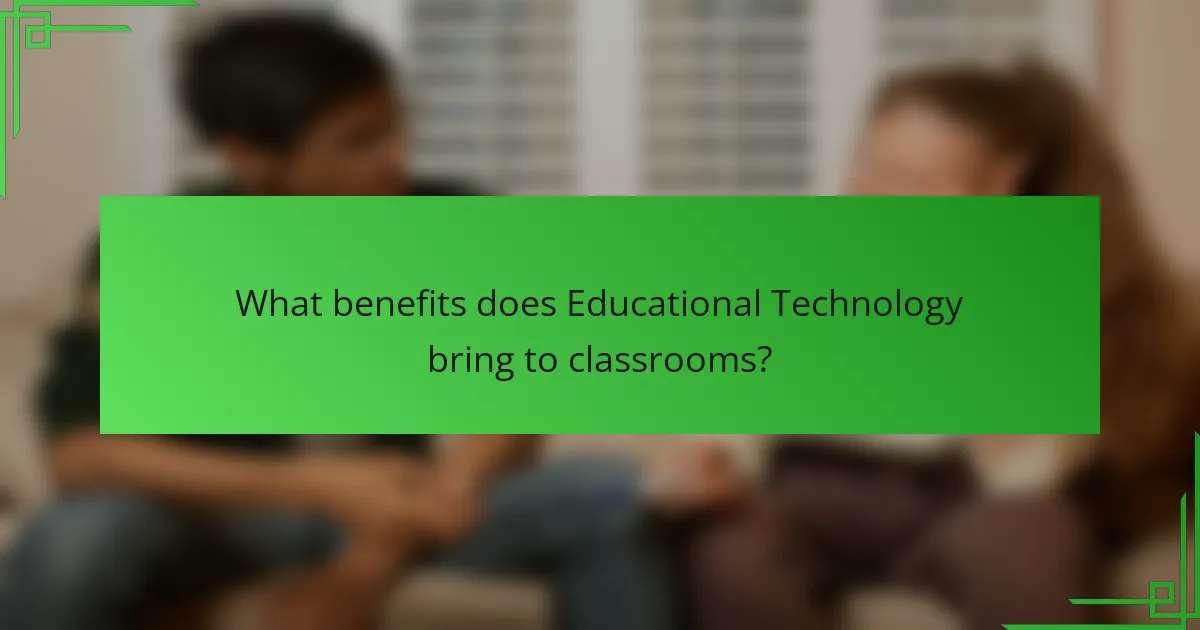
What benefits does Educational Technology bring to classrooms?
Educational technology enhances learning experiences in classrooms. It promotes student engagement through interactive tools. These tools include educational software, online resources, and multimedia content. Research shows that technology integration improves academic performance. A study by the U.S. Department of Education found that technology can lead to higher test scores. Additionally, educational technology supports personalized learning. It allows students to learn at their own pace. Teachers can use data analytics to tailor instruction to individual needs. Furthermore, technology fosters collaboration among students. Online platforms enable teamwork and communication beyond classroom walls. Overall, educational technology provides diverse benefits that enrich the learning environment.
How does Educational Technology improve student engagement?
Educational technology improves student engagement by offering interactive and personalized learning experiences. Tools like gamification and multimedia resources capture students’ attention. These technologies facilitate real-time feedback, allowing students to track their progress. Research shows that interactive lessons increase participation rates by up to 40%. Moreover, collaborative tools foster peer interaction and teamwork. According to a study by the University of Michigan, technology-enhanced learning environments lead to higher motivation levels. Overall, educational technology transforms traditional learning into an engaging, dynamic experience.
What role does gamification play in student participation?
Gamification enhances student participation by incorporating game-like elements into educational settings. These elements include rewards, challenges, and competition. They motivate students to engage more actively in learning activities. Research shows that gamified learning environments increase student motivation and engagement levels. A study by Hamari et al. (2014) found that gamification positively impacts user engagement in educational contexts. Gamification fosters a sense of achievement and encourages collaboration among students. This approach can lead to improved learning outcomes and higher retention rates. Overall, gamification serves as an effective tool to boost student participation in educational environments.
How do multimedia resources cater to different learning styles?
Multimedia resources cater to different learning styles by incorporating various formats like text, audio, video, and interactive elements. Visual learners benefit from videos and infographics that illustrate concepts. Auditory learners engage with podcasts and recorded lectures that enhance listening skills. Kinesthetic learners thrive on interactive simulations and hands-on activities that allow for physical engagement. Research indicates that using multimedia can improve retention rates by up to 60% compared to traditional methods. This effectiveness is supported by studies from the University of California that show diverse formats meet the needs of individual learners. By addressing multiple modalities, multimedia resources create a more inclusive learning environment.
What impact does Educational Technology have on learning outcomes?
Educational technology positively impacts learning outcomes by enhancing engagement and facilitating personalized learning. It allows students to access diverse resources and interactive content. This technology supports differentiated instruction tailored to individual learning needs. Research indicates that technology integration can lead to improved academic performance. A study by Hattie (2012) found that technology use can increase student achievement by up to 30%. Additionally, educational technology fosters collaboration among students through online platforms. It encourages critical thinking and problem-solving skills. These factors contribute to a more effective learning environment.
How does technology facilitate personalized learning paths?
Technology facilitates personalized learning paths by allowing tailored educational experiences for individual learners. It utilizes data analytics to assess students’ strengths and weaknesses. Learning management systems enable customized content delivery based on these assessments. Adaptive learning technologies adjust the difficulty of tasks in real-time. Online platforms provide diverse resources that cater to different learning styles. Gamification elements engage students and motivate them to progress at their own pace. Research shows that personalized learning can improve student outcomes significantly. A study by the Bill & Melinda Gates Foundation found that personalized learning approaches led to higher student engagement and achievement.
What evidence supports the effectiveness of Educational Technology in improving academic performance?
Educational Technology enhances academic performance through various evidence-based studies. A meta-analysis by Hattie (2017) found that technology integration in classrooms can lead to an effect size of 0.57, indicating a significant positive impact on learning outcomes. Additionally, a study published in the Journal of Educational Psychology showed that students using educational apps scored 20% higher on assessments compared to those who did not. Furthermore, research from the University of Michigan demonstrated that online learning environments can increase student engagement, leading to improved retention rates. These studies collectively support the effectiveness of Educational Technology in fostering better academic performance.
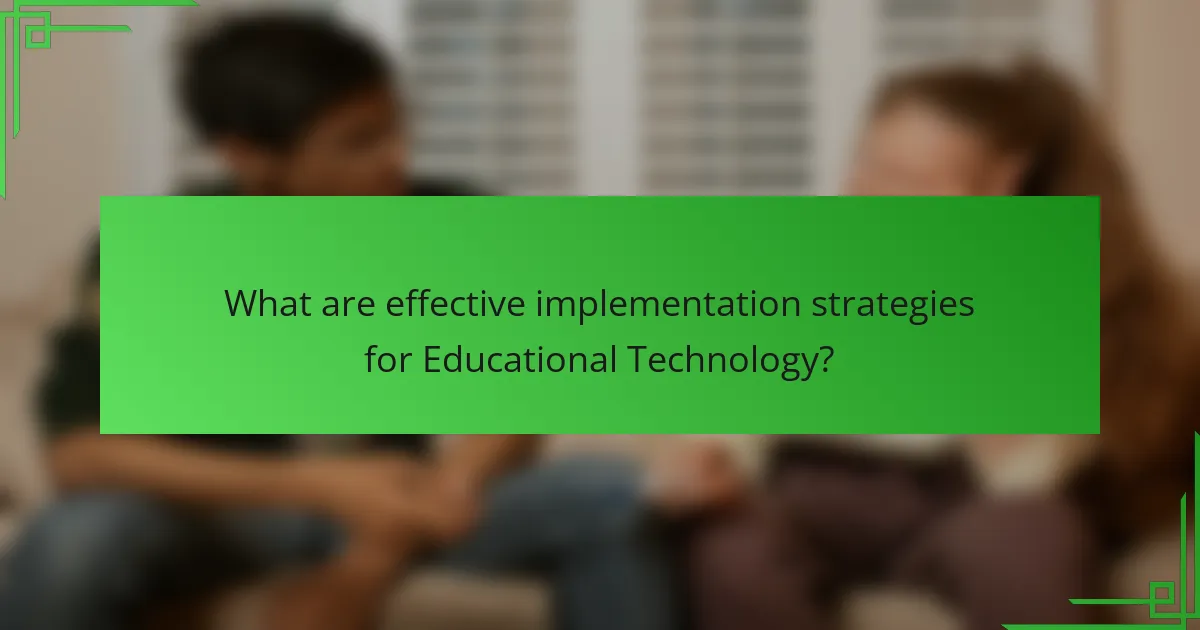
What are effective implementation strategies for Educational Technology?
Effective implementation strategies for Educational Technology include thorough training for educators. This training enhances their ability to integrate technology into lesson plans. Additionally, providing ongoing support ensures teachers can troubleshoot issues as they arise. Establishing clear objectives for technology use aligns it with educational goals. Furthermore, involving stakeholders, including students and parents, fosters a collaborative environment. Regular assessment of technology’s impact on learning outcomes informs necessary adjustments. Research shows that schools with structured implementation plans see improved student engagement and achievement. For instance, a study by the International Society for Technology in Education found that effective training programs significantly boost teachers’ confidence in using technology.
How can educators successfully integrate technology into their teaching?
Educators can successfully integrate technology into their teaching by strategically selecting digital tools that enhance learning. First, they should identify specific learning objectives. This ensures that technology supports educational goals. Next, educators can incorporate interactive platforms, such as learning management systems or educational apps. These tools facilitate engagement and collaboration among students. Additionally, professional development is crucial. Training helps educators understand how to effectively use technology in their lessons. Research shows that teachers who receive training are more confident in their technology use. A study by the International Society for Technology in Education found that effective integration can improve student outcomes. Finally, continuous assessment of technology use is essential. This allows educators to adapt and refine their approaches based on student feedback and performance.
What training do teachers need for effective technology integration?
Teachers need professional development focused on technology integration for effective classroom use. This training should cover pedagogical strategies that incorporate technology. Teachers should learn to evaluate and select appropriate digital tools. They need to understand how to align technology with curriculum standards. Training should also include hands-on experience with various educational technologies. Ongoing support and resources are essential for successful implementation. Research indicates that effective training improves teachers’ confidence and competency in using technology. A study by the International Society for Technology in Education highlights the importance of continuous learning in this area.
How can schools create a supportive environment for technology use?
Schools can create a supportive environment for technology use by implementing comprehensive training programs for teachers. These programs enhance educators’ skills and confidence in using technology effectively. Providing access to updated devices and reliable internet is crucial for seamless integration. Schools should also establish clear policies guiding technology use to ensure responsible behavior. Encouraging collaboration among students through technology fosters engagement and peer learning. Regularly seeking feedback from students and teachers helps to refine technology use strategies. Lastly, promoting a culture that values innovation and adaptability supports ongoing technological advancement in education.
What challenges might educators face when implementing Educational Technology?
Educators may face several challenges when implementing Educational Technology. One significant challenge is the lack of adequate training for teachers. Many educators are not familiar with new technologies, leading to ineffective use in the classroom. Additionally, there can be resistance to change from both educators and students. This resistance can hinder the adoption of new tools and methods.
Another challenge is the disparity in access to technology among students. Some students may lack the necessary devices or internet access, creating an unequal learning environment. Furthermore, integrating technology into existing curricula can be complex. Educators must find ways to align technology with educational standards and learning objectives.
Budget constraints also pose a challenge. Schools may struggle to fund new technologies or maintain existing equipment. Finally, data privacy and security concerns are prevalent. Educators must ensure that student information is protected while using various educational platforms. These challenges collectively impact the effective implementation of Educational Technology in classrooms.
How can schools address issues of access and equity in technology use?
Schools can address issues of access and equity in technology use by implementing targeted strategies. One effective approach is providing devices to students who lack access. A study by the Pew Research Center found that 15% of U.S. households with school-aged children do not have internet access. Schools can also establish community partnerships to improve internet connectivity. Furthermore, offering training for both students and teachers increases digital literacy. Research shows that equitable technology use enhances educational outcomes. Schools should regularly assess technology needs to ensure all students benefit. This proactive approach fosters an inclusive learning environment.
What are common technical issues that can arise during implementation?
Common technical issues during implementation include software compatibility problems. These often arise when new tools do not integrate with existing systems. Hardware malfunctions can also occur, impacting device functionality. Network connectivity issues frequently disrupt access to online resources. Insufficient training can lead to user errors and decreased effectiveness. Data privacy concerns may emerge, particularly with student information. Additionally, inadequate technical support can hinder troubleshooting efforts. Each of these issues can significantly affect the overall success of educational technology initiatives.
What best practices should educators follow when using Educational Technology?
Educators should follow several best practices when using educational technology. First, they should align technology use with learning objectives. This ensures that technology serves a clear educational purpose. Second, educators must provide training for both themselves and their students. Familiarity with tools enhances engagement and effectiveness. Third, they should encourage collaboration through technology. Collaborative tools can foster communication and teamwork among students. Fourth, educators should assess the effectiveness of technology regularly. Continuous evaluation helps in adapting and improving the use of tech tools. Fifth, they must ensure accessibility for all students. This includes considering diverse learning needs and providing appropriate resources. Lastly, educators should stay updated on emerging technologies. Keeping informed allows them to leverage the latest advancements in education. These practices collectively enhance the integration of technology in learning environments.
How can teachers evaluate the effectiveness of the technology they use?
Teachers can evaluate the effectiveness of the technology they use by assessing student engagement and learning outcomes. They can track metrics such as test scores and assignment completion rates. Surveys and feedback from students provide valuable insights into their experiences. Observations during class can reveal how well technology facilitates learning. Comparing performance before and after technology implementation can indicate its impact. Additionally, analyzing usage data from educational software can highlight areas of improvement. Research shows that effective evaluation leads to better technology integration in classrooms. This aligns with findings from the “Technology in Education: A Review of the Literature” by the National Education Association, which emphasizes the importance of data-driven decision-making in educational technology.
What strategies can be employed to ensure technology enhances learning rather than distracts from it?
Establishing clear guidelines for technology use in classrooms enhances learning. These guidelines should define acceptable technology applications and set boundaries for off-task behavior. Training teachers on effective technology integration is essential. Educators need to understand how to use tools that promote engagement and critical thinking. Incorporating interactive and collaborative tools can also enhance learning experiences. For instance, platforms like Google Classroom foster collaboration among students. Moreover, regularly assessing the impact of technology on learning outcomes helps identify effective practices. Research indicates that structured technology use leads to improved student performance. A study by the Bill & Melinda Gates Foundation found that technology can personalize learning and increase student engagement when used effectively.
Educational technology in classrooms encompasses the integration of digital tools and resources designed to enhance learning experiences and improve student engagement. The article explores the evolution of educational technology, highlighting key milestones such as the introduction of computers and the internet, and discusses the various types of tools, including Learning Management Systems and interactive whiteboards. It also examines the benefits of technology in promoting personalized learning and collaboration, the challenges educators face during implementation, and effective strategies for integrating technology into teaching practices. Additionally, the article emphasizes the importance of training for educators and the need for equitable access to technology in order to maximize its impact on learning outcomes.
